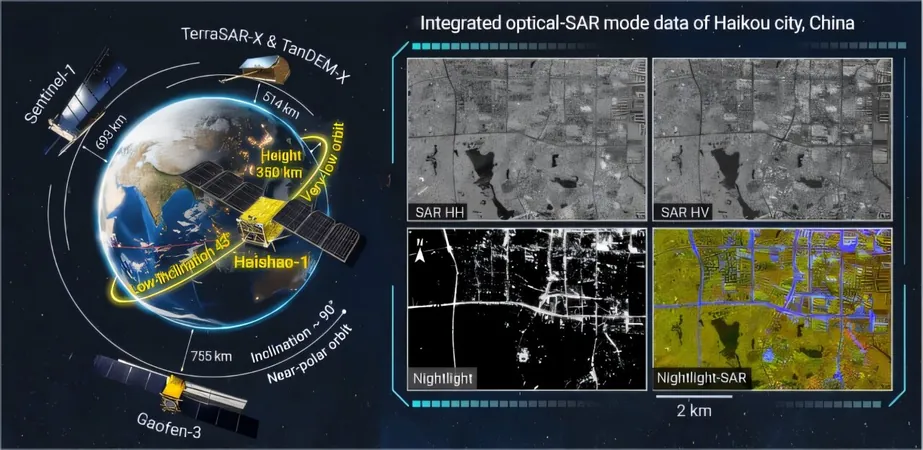
Jaw-Dropping Discovery: Astronomers Unveil the Universe's Biggest Cosmic Structure Yet!
2025-06-09
Author: Jia
In an astonishing leap forward for astrophysics, astronomers at the Center for Astrophysics | Harvard & Smithsonian have uncovered the largest known cloud of energetic particles cloaking a galaxy cluster, measuring a mind-boggling 20 million light-years in diameter! This groundbreaking discovery not only defies the conventional wisdom of how particles maintain their energy over time but also opens up a new chapter in our understanding of the cosmos.
Located a staggering five billion light-years from our planet, the massive galaxy cluster known as PLCK G287.0+32.9 has been an object of intrigue since its discovery in 2011. Initial observations highlighted two brilliant shockwave relics illuminating the cluster's peripheries, yet what eluded previous studies was the colossal, faint radio emission saturating the space in between. New radio imagery reveals this entire structure radiating a subtle yet powerful glow—almost 20 times wider than our own Milky Way!
Dr. Kamlesh Rajpurohit, the lead author of the study, expressed his surprise stating, "We expected to see just a bright pair of relics at the edges, but instead, we uncovered the entire cluster shimmering in radio light. A cloud of energetic particles of this magnitude has never been documented before in this galaxy cluster, or any other, for that matter." The former record was held by Abell 2255, measuring approximately 16.3 million light-years.
At the heart of this titanic cluster, researchers detected a remarkable radio halo about 11.4 million light-years wide, marking the first sighting of such a large halo at 2.4 GHz—a frequency where such expanses typically elude visibility. This revelation poses intriguing questions regarding the dynamics of cosmic ray electrons and magnetic fields extending across the cluster. How can these electrons be accelerated over such vast distances remains an enigma.
Rajpurohit stated, "Typically, extensive radio halos are only noticeable at lower frequencies because the resulting electrons have lost energy and cooled off over time. With this discovery, we are observing radio emissions that stretch across the entire cluster, indicating something is actively at work in accelerating or re-accelerating these electrons. However, conventional explanations do not apply here. We speculate that powerful shockwaves or turbulent movements could be the culprits, but further theoretical modeling is necessary to confirm this hypothesis."
This discovery offers a fresh perspective for scientists eager to investigate cosmic magnetic fields—one of the great mysteries of astrophysics—which play a crucial role in shaping the Universe at colossal scales. Rajpurohit added, "We're beginning to chart the cosmos in ways never imagined before. This necessitates a reevaluation of how energy and matter navigate the Universe's grand structures."
Further observations utilizing NASA's Chandra X-ray Observatory have depicted venerable features like box-shaped structures and comet-like tails within the cluster's heated gases, indicating further disturbance within this colossal formation. Some of these X-ray structures align with the radio features, implying that mergers within the cluster could be intensifying electron acceleration. It is possible that either a merger of two smaller galaxy clusters or outbursts from a supermassive black hole—or both—could be fueling these phenomena.


 Brasil (PT)
Brasil (PT)
 Canada (EN)
Canada (EN)
 Chile (ES)
Chile (ES)
 Česko (CS)
Česko (CS)
 대한민국 (KO)
대한민국 (KO)
 España (ES)
España (ES)
 France (FR)
France (FR)
 Hong Kong (EN)
Hong Kong (EN)
 Italia (IT)
Italia (IT)
 日本 (JA)
日本 (JA)
 Magyarország (HU)
Magyarország (HU)
 Norge (NO)
Norge (NO)
 Polska (PL)
Polska (PL)
 Schweiz (DE)
Schweiz (DE)
 Singapore (EN)
Singapore (EN)
 Sverige (SV)
Sverige (SV)
 Suomi (FI)
Suomi (FI)
 Türkiye (TR)
Türkiye (TR)
 الإمارات العربية المتحدة (AR)
الإمارات العربية المتحدة (AR)